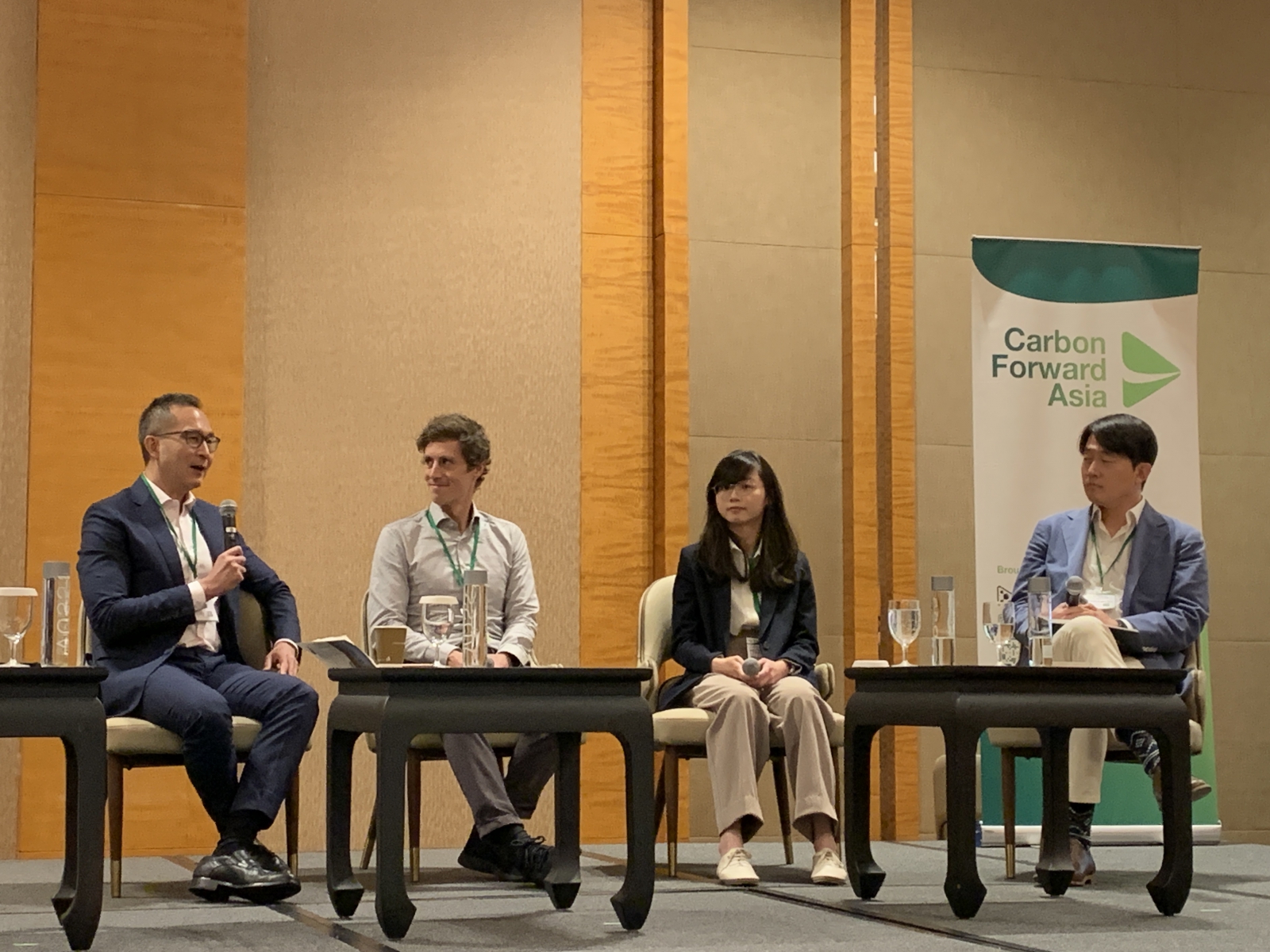At the annual Asia-Pacific carbon market event Carbon Forward Asia, a panel titled “Removals: Putting the Net into Net-Zero” was held on March 5. From left: Alvin Lee, Regional Head APAC at Puro.Earth; Ikarus Janzen, Chief Commercial Officer at Varaha; Stephanie Chiang, senior research analyst at Wood Mackenzie; and Leo Park, Vice President at Capture6. (Photo: Carol Chen)
Carbon Forward Asia, held from March 4 to 5 in Singapore, featured a panel on the second day titled “Removals: Putting the Net into Net-Zero,” which explored the opportunities and challenges for advancing carbon removal in Asia.
“Carbon prices are too low to create real demand for carbon removal,” said Leo Park, vice president of direct air capture startup Capture6, during a discussion with senior research analyst Stephanie Chiang of Wood Mackenzie and Chief Commercial Officer Ikarus Janzen of Varaha.
Carbon removal demand to hit 8 billion tonnes by 2050
To achieve net-zero emissions, the scale of carbon removal must expand significantly, with around 1 to 8 billion tonnes of carbon removal will be needed annually by 2050, according to Chiang.
However, only around 100 million tonnes of carbon removal credits had been issued globally as of the end of 2024—just 1% of the target—highlighting a vast gap between current market scale and long-term demand.
“We see strong potential for carbon removal in India and particularly Southeast Asia, across both nature-based and permanent removal solutions,” said Janzen of Varaha, an India-based startup working on projects like regenerative agriculture, afforestation, biochar, and enhanced rock weathering.
He pointed to three key advantages that position Asia to lead in carbon removal:
- Abundant biomass: Tropical regions support rapid biomass production, which can be used for biochar. In India alone, over 100 million tons of crop residue are burned annually, and these could be converted into biochar and returned to the soil for carbon removal.
- Ample labor force: Both afforestation and biochar production are labor-intensive, and Asia’s large labor pool makes such efforts more feasible.
- Favorable geology: India has rich mineral resources, including basalt, which is suitable for enhanced rock weathering (ERW). High rainfall and warm temperatures in the tropics further accelerate the weathering process.
That’s why India and other tropical regions are ideal and cost-effective for scaling carbon removal, Janzen said.

The biochar production process can capture and store carbon dioxide from the atmosphere. (Photo: MIT Climate)
Capture6, a South Korea-based direct air capture (DAC) startup, takes a different approach from conventional DAC technologies by focusing on both carbon removal and value creation. According to Park, the system uses brine as a feedstock and applies an electrochemical process to produce sodium hydroxide, which is then used to capture carbon dioxide from the atmosphere.
Capture6’s carbon removal technology offers several benefits. It can recover up to 70% of freshwater from brine, helping address water scarcity. The process also produces industrial chemicals such as hydrochloric acid, chlorine, and hydrogen that can be supplied to other industries. Additionally, it can increase ocean alkalinity, enhancing the ocean’s capacity to absorb carbon dioxide.
Asia eyes carbon removal growth as regulations evolve
Although Asia holds strong potential for carbon storage, particularly with its depleted oil and gas fields and saline aquifers, its regulatory framework for carbon capture, utilization, and storage (CCUS) still lags behind North America and Europe. To catch up, countries including Indonesia and Malaysia have introduced carbon storage regulations in recent years to encourage net-zero investments.
Currently, the cost of carbon removal technologies such as bioenergy with carbon capture and storage (BECCS) and direct air capture with carbon storage (DACCS) remains high. DACCS can reach several hundred dollars per tonne, costing up to USD 900 per tonne.
To drive demand for carbon removal, carbon pricing is key. According to Park, South Korea’s carbon market remains sluggish, with prices below USD 10 per tonne, a level that is unrealistic to expect companies to pay up to 100 times more for carbon removal technologies.
Currently, most buyers of carbon removal credits are Fortune 500 companies in the U.S. and major corporations in Europe, while Asian companies have remained absent from the market.
As recently as January, Varaha signed a contract with Google to supply 100,000 tons of biochar carbon credits.
Large corporations tend to focus their investments in specific areas rather than spreading them across multiple developers, and often evaluate partnerships based on scale, Janzen said. As a result, signing large carbon removal deals usually takes six to 18 months to ensure alignment with corporate strategies and long-term goals.

.jpg)


